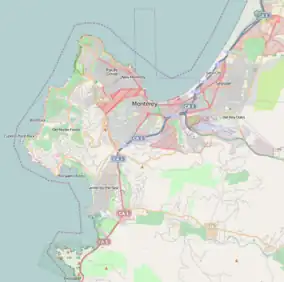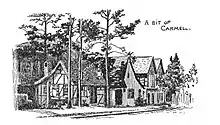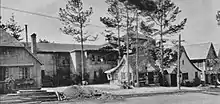Sade's
Sade's is a one-and-one-half-story, commercial building in downtown Carmel-by-the-Sea, California. It was built in 1925, for novelist and dramatist Harry Leon Wilson and his wife Helen MacGowan Cooke as a flower shop and dress shop. In the 1930s, Sade (Sade Carr-Latham) was a former Ziegfeld Follies dancer, made the lower level into a restaurant and bar that was nationally renowned. The building was designated as a significant commercial building in the city's Downtown Historic District Property Survey, and was recorded with the Department of Parks and Recreation on January 28, 2002.[1] The first floor of the building is now occupied by the Porta Bella Mediterranean restaurant and bar. The second floor is occupied by Kids by the Sea.
| Sade's | |
|---|---|
| El Matador | |
 Sade's in the Court of the Golden Bough | |
| Location | Ocean Avenue & Lincoln Street, Carmel-by-the-Sea, California |
| Coordinates | 36°33′17″N 121°55′26″W |
| Built | 1925 |
| Built by | Lee Gottfried |
| Built for | Harry Leon Wilson |
| Original use | Flower shop |
| Current use | Retail stores |
| Architect | Lee Gottfried |
| Architectural style(s) | Tudor Revival |
| Website | Porta Bella |
 Sade's Location in the Monterey Peninsula | |
History


Sade's is a two-story, wood-framed Tudor Revival style commercial building in Carmel-by-the-Sea, California, built for Harry Leon Wilson (1867-1939). The exterior walls are textured cement stucco. It has two steep pitched side-gabled roofs, and two chimneys. There is a Carmel stone entry to the building in the Court of the Golden Bough, with other small “old world” shops. The entry has a round wood planked door with a window and an outside staircase that leads to the second floor. Behind the courtyard was the entrance to the Theatre of the Golden Bough. Because of this, the courtyard has been named the Courtyard of the Golden Bough.[1]
The shops in the courtyard include Sade's (now Porta Bella’s with patio dining), Seven Arts Shop (now Body Frenzy) and the Carmel Weavers Studio (now Cottage of Sweets).[2][1][3]
Sade's was built in May 1925, two years after Edward G. Kuster and Gottfried completed the first European shop, the Carmel Weavers Studio, in an area of the Court of the Golden Bough, at Monte Verde and Ocean Avenue. Writer and editor Harry Leon Wilson commission Lee Gottfried to build the "Bloomin Basement," a flower shop, for his wife, Helen MacGowan Cooke. The shop was built for $8,000 (equivalent to $133,495 in 2022.[4][1][5][6]
In Carmel-by-the-Sea, on Ocean avenue, there is a group of little shops that might well be transferred to an artist's canvas and labeled, "A Bit of Old Europe."
— Daisy Bostick
April 4, 1924[7]
A flavor of Italy is twisted into the wrought-iron sign swinging from the front of the Court of the Golden Bough, about which cluster some of the most interesting and lovely of the Carmel shops...The proprietor of The Seven Arts was a professional actor and stage director...The owner of the shops and theater which form the Court of the Golden Bough was a professional cellist, and formerly business manager of one of the largest symphony orchestras in the West.
— Tirey L. Ford
1926[8]
In the 1930s, Sade Carr-Latham herself, a former Ziegfeld Follies dancer, made the lower level into a restaurant and bar. Sade's became a popular meeting place for the many Bohemian actors, artists, and writers associated with Kuster's Golden Bough Theater, including George Sterling, Mary Austin, and Jack London.[9]
For fifty years Sade's was one of the most popular social spots in the village and became nationally renowned.[1][4] Sade died of a heart attack at her home in Carmel Woods on November 11, 1940.[10]
On December 28, 1951, Paul Swanson became the owner of Sade's. He was manager of the restaurant since 1934.[4][11] Swanson purchased the restaurant and cocktail lounge from Margaret and Bertram Dienelt, owner of the Mission Ranch since early 1941.[12] Joel Thomas changed the name to El Matador. The building changed hands many times, with the name changing back to Sade's, until its last opening day on February 26, 1994.[4]
The building qualifies for inclusion in the Downtown Historic District Property Survey because it contributes to the overall design of the historic Court of the Golden Bough, and it is a good example of Tudor Revival design by Carmel builder Lee E. Gottfried.[1]
See also
References
- Kent L. Seavey (January 28, 2002). "Department Of Parks And Recreation" (PDF). National Park Service. Retrieved April 5, 2022.
- Bostick, Daisy F.; Castelhun, Dorothea (1977). Carmel at Work and Play. p. 68. Retrieved 2022-04-05.
{{cite book}}:|work=ignored (help) - Seavey, Kent (2007). Carmel, A History in Architecture. p. 74. ISBN 9780738547053. Retrieved 2022-04-04.
{{cite book}}:|work=ignored (help)CS1 maint: location missing publisher (link) - Scott Bearton (September 9, 1994). "A look back at Sade's colorful past". Carmel Pine Cone. Retrieved April 7, 2022.
- Dramov, Alissandra (2019). Historic Buildings of Downtown Carmel-by-the-Sea. Carmel-by-the-Sea, California: Arcadia Publishing. pp. 62, 77. ISBN 9781467103039. Retrieved 2022-04-04.
- "The Bloomin Basement Court of the Golden Bough". Carmel Pine Cone. June 21, 1924. p. 7. Retrieved April 7, 2022.
- Daisy F. Bostick (April 4, 1924). "Carmel Boasts of America's Best Equipped Studio Theater". Carmel Pine Cone. Retrieved April 4, 2022.
- Ford, Tirey L. (1926). Dawn and the Dons; the Romance of Monterey. The Bruce Brouch Press. pp. 204–206. Retrieved 2022-04-05.
- Dramov, Alissandra (2022). Past & Present Carmel-By-The-Sea. Charleston, South Carolina: Arcadia Publishing. p. 44. ISBN 9781467108980. Retrieved 2023-03-08.
- "Sade Taken Suddenly Away". Carmel Pine Cone. 22 Nov 1940. p. 1. Retrieved June 17, 2022.
- "Paul Swanson Now Owner Of Sade's". Carmel Pine Cone. 4 January 1952. p. 4. Retrieved June 17, 2022.
- Neal Hotelling (31 December 2021). "Hobby-horse races and pinball machines at Mission Ranch" (PDF). Carmel Pine Cone. p. 23. Retrieved June 17, 2022.